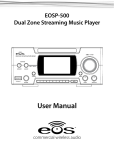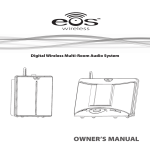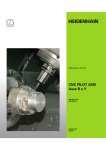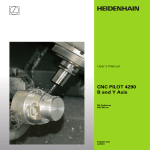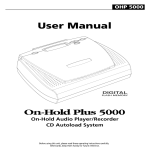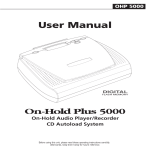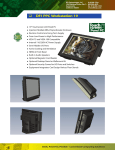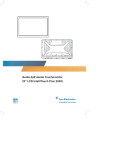Download EOS EOSP-500 User manual
Transcript
EOSP-622 Dual Zone Wireless Speaker User Manual TM commercial wireless audio Thank You For Choosing Eos Wireless! We hope you will get much enjoyment from your wireless audio system. Please read the entire contents of this manual. It is filled with reference information that will allow you to get the most from your new Eos system. If you have any questions, please check our web site at pro.eoswireless.com/support or call us at 877-465-3927. Your Total Satisfaction – Eos Job #1 Congratulations on your purchase of the Eos Digital Pro Series Audio System. We are committed to making sure your experience is problem free. If you experience any difficulty and/or have any questions regarding the Eos system that are not addressed in this manual, please feel free to contact the Eos Technical Support Team, tollfree, at 877-465-3927 (between the hours of 8:30 AM and 5 PM pacific time.) Our Eos Support Team aims to offer quick, comprehensive and thorough technical support to all our users. Before you call, please make sure you have your Eos unit model number and serial number on hand. TM commercial wireless audio 877-465-3927 www.eoswireless.com/pro 2 Table Of Contents Contents Important Safety Instructions FCC Information Limited Warranty 4 5 6 Product Support 6 Wireless System Setup 7 Linking Procedure 7 Adding Additional Wireless Speakers/Receivers 7 Controls & Functions Wireless Speaker Operation 8 9 Channel Switch 9 Volume Control 9 Zone Switch 9 Link Button 9 IR Remote Control 9 Wireless Speaker Sleep Mode 9 Remote control setting increments 9 Mounting Options 10 Wall Outlet Mounting 10 Wall Outlet Mounting on Inverted Outlets 10 Removing the integrated power supply 10 Mounting Options 11 Wall Mounting 11 Hiding Power Cords 11 Getting the most out of your wireless audio Wireless Audio Troubleshooting Guide 3 12 13 A Consumer Guide to Product Safety Important Safety Instructions Please take the time to follow the instructions in this manual carefully. It will help you set up and operate your system properly and enjoy all of the advanced features. Please save this manual for future reference. WARNING: To reduce the risk of fire or electrical shock, do not expose the product to rain or moisture. Avoid prolonged exposure to direct sunlight. WARNING: Liquids can cause a failure and/or a fire hazard. The unit should not be exposed to liquid dripping or splashing. Avoid placing objects filled with liquids, such as coffee cups, soda cans or vases on the unit. As with any electronic product, use care not to spill liquids into any part of the system. WARNING: No open flame sources, such as lighted candles, should be placed on the unit. Note: The product label is located on the bottom of the product. This product is intended to be used only with the power supply provided. Using another power supply can cause damage to the unit. This product is intended for indoor use. If used outdoors, care should be exercised in placing the product in an area that is well sheltered from the outdoor environment. Safety Instructions 1. Read instructions before using this product. 2. Keep these instructions for future reference. 3. Heed all warnings on the product and in the manual. 4. Follow all instructions. 5. Do not use this unit near water or moisture. Do not use this product near a bathtub, washbowl, kitchen sink, laundry tub, in a wet basement, near a swimming pool, or anywhere else that water or moisture are present. Clean only with a dry cloth and as directed by IntelliTouch. Unplug this product from the power supply before cleaning. Avoid prolonged exposure to direct sunlight or heat. Do not install near any heat sources, such as radiators, heat registers, stoves or other unit (including amplifiers) that produce excess heat. 9. Only use attachments/accessories specified by the manufacturer. 10. Unplug this unit during lightning storms or when unused for long periods of time – to prevent possible damage to this product. 11. Refer all servicing to qualified service personnel. Servicing is required when the unit has been damaged in any way such as: power supply cord or plug is damaged; liquid has been spilled or objects have fallen into the unit; the unit has been exposed to rain or moisture, does not operate normally, or has been dropped. Do not attempt to service this product yourself. 12. Opening or removing covers may expose you to dangerous voltages or other hazards. 13. To prevent risk of fire or electric shock, avoid overloading wall outlets, extension cords, or integral convenience receptacles. 14. Do not let objects or liquids enter the product as they may touch dangerous voltage points or short-out parts that could result in a fire or electric shock. 15. Use proper power sources - Plug the product into a proper power source, as described in this manual or as marked on the product. 6. 7. 8. 4 A Consumer Guide to Product Safety FCC Information Information about products that generate electrical noise if applicable, this equipment has been tested and found to comply with the limits for a Class B digital device, pursuant to Part 15 of the FCC rules. These limits are designed to provide reasonable protection against harmful interference in a residential installation. This equipment generates, uses, and can radiate radio frequency energy and, if not installed and used in accordance with the instructions, may cause harmful interference to radio communications. However, this is no guarantee that interference will not occur in a particular installation. If this equipment does cause harmful interference to radio or television reception, which can be determined by turning the equipment off and on, you are encouraged to try to correct the interference by one or more of the following measures: • Reorient or relocate the transmitter and/or receiver. • Increase the separation between the equipment and transmitter and/or receiver. • Connect the equipment to an outlet on a different circuit than the one to which the transmitter and/or receiver is connected. • Consult the dealer or an experienced radio/TV technician for help. FCC Caution: Any changes or modifications not expressly approved by the party responsible for compliance could void the user’s authority to operate this equipment. This device complies with Part 15 of the FCC Rules. Operation is subject to the following two conditions: (1) This device may not cause harmful interference, and (2) this device must accept any interference received, including interference that may cause undesired operation 5 A Consumer Guide to Product Safety Limited Warranty IntelliTouch warrants this product to be free from manufacturing defects in material and workmanship under normal use and conditions for a period of 1-year from date of original purchase in the United States. In order to validate your warranty, you must register your product by going on-line (pro.eoswireless.com/register), or by calling 877-465-3927 between Monday through Friday, 8:30AM to 5PM Pacific Time. For Warranty service outside the United States, contact the reseller that you purchased the Eos product from. Should service be necessary under this warranty for any reason due to manufacturing defect during this 1-year period from date of original purchase, IntelliTouch will either repair the unit or replace it with a reconditioned unit at no charge. U.S. Warranty Service - You must call (877-465-3927) to obtain a return authorization number prior to sending your product in for service. Pack the unit in a well-padded, heavy, corrugated box. 1. Include a note with reason for return along with RMA number and return shipping information. 2. Enclose proof of purchase. 3. Enclose your check or money order payable to IntelliTouch in the amount of $20.00 to cover shipping and handling costs. 4. Enclose your name, return address and contact number. 5. Ship the unit prepaid via UPS or parcel post (insured). This warranty is void if the product is: 6. Damaged through negligence, misuse, abuse, moisture or accident. 7. Modified in any way. 8. Damaged because it is improperly connected to the equipment of other manufacturers. This warranty does not cover: 9. Damage to equipment not properly connected to the product. 10.Costs incurred in the shipping of the product to IntelliTouch. 11.Damage or improper operation of unit caused by customer abuse, misuse, negligence, or failure to follow instructions in the manual provided with the product. 12.Ordinary adjustments to the product that can be performed by customer as outlined in the manual. 13.Damage to computer or audio equipment Eos Wireless Pro Series Products are designed and manufactured by: IntelliTouch 6370 Nancy Ridge Rd. #105 San Diego, CA 92121 Product Support Visit pro.eoswireless.com/support Support Phone - 877-465-3927 6 Set Up Wireless System Setup The Eos Pro Series Wireless Speakers can receive wireless audio from either the EOSP-500 Dual Zone Music Player with the EOSP-510 wireless transmitter card installed or from the EOSP-610 transceiver in the transmit mode. Transmitters are referred as TX in this manual and receivers as RX. Linking Wireless Transmitters & Wireless Speakers Before initial use, you must link the wireless transmitter (TX) with the wireless speakers. Follow the simple steps below to perform this linking procedure. You can link up to 8 wireless speakers/transceivers (in receive mode) to the transmitter. To simplify the process, it is recommend that you do the below process with the transmitter and receivers in close proximity to each other to avoid having to run back and forth between them. Note - The receivers will retain their link to the transmitter, even after being powered down and moved to their final location. TX Card Link Button TM Set MODE to TX Wireless Transceiver Link Button Wireless Speaker Link Button Linking Procedure (Note - linking procedure needs to be done on each wireless speaker receiver, one at a time) 1. Power on TX. 2. Using the IR Remote, power on speaker. The Power LED will be ON and the Link LED will flash slowly. 3. Press the link button on the TX. The Status LED will flash quickly. 4. Press the link button of speaker. The Link LED will flash quickly. 5. If the pairing of TX and speaker is successful, the status LED of both TX and speaker will be SOLID. Note - If the pairing is not successful, after one minute, the status LED of the TX will go back to ON and LED on the RX will return to flashing slowly. Adding Additional Wireless Speakers/Receivers After initial setup, you can add additional wireless speakers/transceivers (in RX mode) to the system at any time by following the same procedure. When adding new wireless speakers/ transceivers to the system, you only need to perform the procedure on the new wireless speakers/receivers. 7 Connections Controls & Functions Channel Switch Allows selection of Right, Left of Mono Audio output Volume Control Adjusts the local volume setting of the wireless speaker Zone Select Allows the selection of Zone 1 or Zone 2 output Link Button Used to link the wireless speaker with the transmitter Volume Controls Controls local volume of the wireless speaker Tone Controls Allows you to tune the speaker acoustics the type of music and the room acoustics Power Status LED Displays the Power status of the speaker Link Status LED Displays the Link status of the speaker Station Presets Allows you to select from the stored station presets on the Streaming Music Player (EOSP-500). Must be used line of sight of the player 8 Connections Wireless Speaker Operation Channel Switch The Wireless Speaker can be set to receive either Right or Left Channel audio or Mono audio from a stereo signal. Volume Control Master volume is set at the transmitter/source end. Local volume for each speaker can be adjusted either from the speaker or from the IR wireless remote control. The IR wireless remote control can also set the bass, treble and loudness of the speaker. Zone Switch The Wireless Speaker is Dual Zone. Depending on the transmitter source that you want to receive, you can set the Zone Switch to either Zone 1 or Zone 2. Link Button This button is used to pair the Wireless Speaker with the Transmitter. IR Remote Control Remote control works on line of sight with the wireless speaker. To use remote, stand close to the speaker you are adjusting and point the front of the remote at the speaker. Wireless Speaker Sleep Mode If the transmitter is turned off, the wireless speaker will go into a low power sleep mode. When in Sleep mode the POWER staus LED will be off. This sleep mode avoids having turn off all the speakers individually. When the transmitter is powered back on, the speakers detect this and power themselves back on automatically, the POWER status LED will return to on. Remote control setting increments For optimal sound quality, each wireless speaker can be adjusted individually. Below are the setting increments for the wireless speaker using the remote control. Treble - 7 steps (3 down to min - flat - 3 up to max) 2dB increments Bass - 7 steps (3 down to min - flat - 3 up to max) 2dB increments Loudness - 15dB increase (up on/down off ) Volume - 32 steps (min to max) 9 Mounting Mounting Options Wall Outlet Mounting A unique design feature of the wireless speaker is that it can be plugged into a wall outlet for mounting. For added support a security wall bracket mount is included in the package. To use this bracket, see the diagram below. Wall Outlet Mounting on Inverted Outlets In instances where the wall outlet is upside down (grounding pin at the top of the outlet), the non-functional grounding pin on the wireless speaker can be removed by unscrewing it. With the grounding pin removed, it is advised that you use the security wall bracket mount to keep the speaker from falling out of the wall outlet. Removing the integrated power supply A traditional power supply with 6’ feet of cable is integrated into the cabinet of the wireless speaker. If you wish to remove the power supply for your installation follow these steps: 1. Remove the 4 Phillips head screws Remove 4 Phillips 2. Lift off plastic plate to expose the power supply head screws 3. Remove power supply and cord 4. Unplug the power supply jack at the connector and route the connector end of the cable though the hole in the plastic plate 5. Reconnect the power cable to the connector in the speaker 6. Replace plastic plate back on the speaker and reinstall the 4 Phillips head screws 10 Mounting Mounting Options Wall Mounting The wireless speaker can be wall mounted using the optional swiveling wall mount speaker kit (EOSP-5). In wall mounting applications an ordinary extension cord can be used to provide power to the speaker. To mount using the swiveling wall mounting kit, see the diagram below. Complete intallation information can be found in the EOSP-5 instruction guide included with the wall mounting kit (EOSP-5). Hiding Power Cords When wall mounting the speaker, you’ll want to hide the power cord with a self adhesive cord channel raceway available from most home improvement stores in a variety of sizes and configurations. Route the extension cord though the raceway and attach to the wall with the self adhive strip on the raceway. 11 Troubleshooting Getting the most out of your wireless audio Eos wireless is pure magic but if you experience problems here’s a few suggestions and tips to help you get the best performance possible. If wireless speaker/receiver falls out of range of the transmitter’s signal, the connection can begin to break up. Wireless speakers and receivers situated near the far reaches of the signal range can experience intermittent audio dropout...but even when a wireless speaker/ receiver well within range, its performance can still be adversely affected by obstructions or interference. The key to extraordinary range is to position your transmitter and wireless speakers/receivers for optimal performance. Below are some good guidelines to follow: Location, location, location! First, keep an open mind for locating for the transmitter. Experiment; try placing the device in several different promising locations. While trial-and-error may not be the most scientific way to find a good spot for your transmitter, it is often the only practical way to assure the best possible wireless audio performance. Strive to install the wireless transmitter in a central location and keep free air around it. Do’s & don’ts Avoid physical obstructions whenever possible. Any barriers along the “line of sight” between transmitters and wireless speakers/receivers degrade the wireless audio signal. Plaster or brick walls tend to have the most negative impact, even obstructions like cabinets, furniture and even people can weaken the signal to some degree. Obstructions tend to reside closer to floor level; therefore, it’s best to get your transmitter up as high as practical...and if you‘re having reception problems on the wireless speaker/receiver end, experiment by getting those up too. Avoid placing the transmitter too close to reflective surfaces whenever possible. Some signals literally bounce off of windows, mirrors, metal file cabinets and stainless steel countertops, lessening both range and performance...so keep this in mind when locating. Avoid placing the transmitter in areas where there are a lot of 2.4GHz signals in close proximity (wireless routers, wireless printers, computers with WiFi). While often not a problem, for optimum results, we recommend a separation of 6’ (2m) between the transmitter and any 2.4GHz radiating devices. Likewise, install the transmitter away from electrical equipment that also generates interference. Avoid electric fans, other motors, and close proximity to fluorescent lighting. 12 Troubleshooting Wireless Audio Troubleshooting Guide Issue No link Solution Make sure that the power LED is illuminated, if not check power connections on the transmit and receive ends. Bring the wireless speaker or receiver close to the transmitter and retry the linking procedure. When linking with Transmitter/Receiver unit, make sure the MODE switch is set to the TX mode. Interference (sound cutting in & out) Make sure antennas are in the vertical position. Elevate transmitter as high as possible. Elevate speakers/receivers as high as possible. Move further away from any wireless router or WiFi enabled computers/printers. Move transmitter to another place in the room or into another room to see if reception improves. Decrease distance between transmitter and wireless speakers/receivers. No sound (link LEDs are steady) Check output & volume on audio source on transmit side. Check to make sure Zone switch is in the proper position on receive side. Check Link status and power Distorted sound Reduce Audio volume at the source. Reduce Audio volume at the wireless speaker. Adjust Bass and Trebile levels (using remote). Turn off Loudness feature (using remote). Low volume Increase Audio volume at the source. Increase Audio volume at the wireless speaker. 13 TM commercial wireless audio 877-465-3927 www.eoswireless.com/pro














